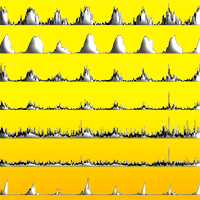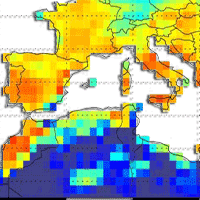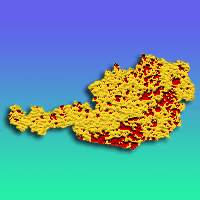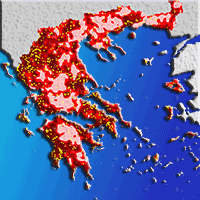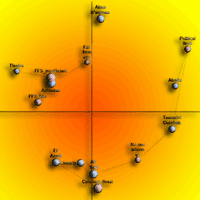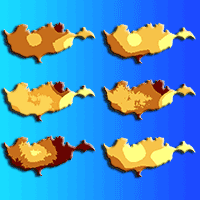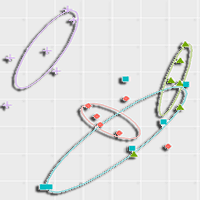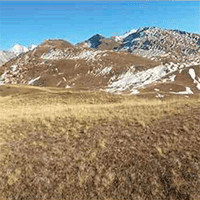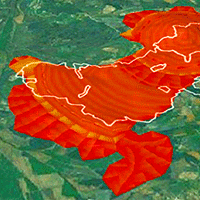The fire danger (FD) defines the conditions less or more favourable for a fire ignition success and its propagation. FD indexes, that integrates environmental variables related to FD in more or less complex equations and systems, are widely used in wildfire prone countries for both scientific and operational purposes. Assessing the performance of FD indexes is challenging and this issue is quite debated within the fire community, which has been trying to apply several methodologies to evaluate FD indexes. The main aim of this work is to give a contribution to this effort. The analysis was conducted using data from a fire-prone Mediterranean area (Sardinia island, Italy), where 8 FD indexes were evaluated and compared using different statistical approaches. We calculated the daily FD values for the period 2000-2007 over the study area. A set of statistical tools (namely Spearman rank correlation, Index Value Distribution and Percentile Analysis, and Logistic Regression) were applied to evaluate the performance of each FD index by comparing FD values with fire occurrence indicators. The statistical tests revealed a large variability in FD indexes performance, depending also on fire activity conditions. Our results showed that two of the tested FD indexes reached a good overall performance. Findings from this study can help both the scientific community and local fire managers, supporting the evaluation of early warning systems and fire prevention strategies in the Mediterranean Basin.
Keywords
, , , ,
Citation
Sirca C, Salis M, Arca B, Duce P, Spano D (2018). Assessing the performance of fire danger indexes in a Mediterranean area. iForest 11: 563-571. - doi: 10.3832/ifor2679-011
Academic Editor
Enrico Marchi
Paper history
Received: Nov 08, 2017
Accepted: Jun 23, 2018
First online: Sep 01, 2018
Publication Date: Oct 31, 2018
Publication Time: 2.33 months
© SISEF - The Italian Society of Silviculture and Forest Ecology 2018
Open Access
This article is distributed under the terms of the Creative Commons Attribution-Non Commercial 4.0 International (https://creativecommons.org/licenses/by-nc/4.0/), which permits unrestricted use, distribution, and reproduction in any medium, provided you give appropriate credit to the original author(s) and the source, provide a link to the Creative Commons license, and indicate if changes were made.

Breakdown by View Type
(Waiting for server response...)
Article Usage
Total Article Views: 61927
(from publication date up to now)
Breakdown by View Type
HTML Page Views: 40852
Abstract Page Views: 3645
PDF Downloads: 3201
Citation/Reference Downloads: 28
XML Downloads: 14201
Web Metrics
Days since publication: 2686
Overall contacts: 61927
Avg. contacts per week: 161.39
Article Citations
Article citations are based on data periodically collected from the Clarivate Web of Science web site
(last update: Mar 2025)
Total number of cites (since 2018): 16
Average cites per year: 2.00
Publication Metrics
by Dimensions ©
Articles citing this article
List of the papers citing this article based on CrossRef Cited-by.
(1)
Andrews PL, Bradshaw LS (1997)Fires: fire information retrieval and evaluation system - a program for fire danger rating analysis. General Technical Report INT-GTR-367, Intermountain Research Station, USDA Forest Service, Ogden, UT, USA, pp. 64.
CrossRef |
Gscholar
(2)
Andrews PL, Loftsgaarden DO, Bradshaw LS (2003)Evaluation of fire danger rating indexes using logistic regression and percentile analysis. International Journal of Wildland Fire 12: 213-226.
CrossRef |
Gscholar
(3)
Arndt N, Vacik H, Koch V, Arpaci A, Gossow H (2013)Modeling human-caused forest fire ignition for assessing forest fire danger in Austria. iForest 6 (5): 315-325.
CrossRef |
Gscholar
(4)
Cardil A, Molina DM, Kobziar LN (2014)Extreme temperature days and their potential impacts on southern Europe. Natural Hazards and Earth System Sciences 14 (11): 3005-3014.
CrossRef |
Gscholar
(5)
Chessa PA, Cesari D, Delitala AM (1999)Mesoscale regimes of precipitation and temperature over Sardinia (Italy) and their related synoptic circulations. Theoretical and Applied Climatology 63: 195-222.
CrossRef |
Gscholar
(6)
Cruz MG, Viegas DX (1998)Fire behaviour in some common central Portugal fuel complexes: evaluation of fire behavior models performances. In: Proceedings of the “III International Conference on Forest Fire Research and the 14th Conference on Fire and Forest Meteorology” (DX Viegas ed). Luso (Coimbra, Portugal), 16-20 Nov 1998. ADAI, Coimbra, Portugal, pp. 829-875.
Gscholar
(7)
Curt T, Borgniet L, Bouillon C (2013)Wildfire frequency varies with the size and shape of fuel types in southeastern France: implications for environmental management. Journal of Environmental Management 117: 150-161.
CrossRef |
Gscholar
(8)
Curt T, Fréjaville T, Lahaye S (2016)Modelling the spatial patterns of ignition causes and fire regime features in southern France: implications for fire prevention policy. International Journal of Wildland Fire 25 (7): 785-796.
CrossRef |
Gscholar
(9)
Dimitrakopoulos AP, Bemmerzouk AM, Mitsopoulos ID (2011)Evaluation of the Canadian fire weather index system in an eastern Mediterranean environment. Meteorological Applications 18 (1): 83-93.
CrossRef |
Gscholar
(10)
Fernandes PM, Loureiro C, Guiomar N, Pezzatti GB, Manso FT, Lopes L (2014)The dynamics and drivers of fuel and fire in the Portuguese public forest. Journal of Environmental Management 146: 373-382.
CrossRef |
Gscholar
(11)
Giannakopoulos C, LeSager P, Moriondo M, Bindi M, Karali A, Hatzaki M, Kostopoulou E (2012)Comparison of fire danger indexes in the Mediterranean for present day conditions. iForest 5: 197-203.
CrossRef |
Gscholar
(12)
Haines DA, Main WA, Frost JS, Simard AJ (1983)Fire-danger rating and wildfire occurrence in the northeastern United States. Forest Science 66: 159-164.
Online |
Gscholar
(13)
Heinsch A, Andrews PL, Kurth LL (2009)Implications of using percentiles to define fire danger levels. In: Proceedings of the “8th Symposium on Fire and Forest Meteorology”. American Meteorological Society (Boston, MA, USA) 12-15 Oct 2009, extended abstract P1.5.
Online |
Gscholar
(14)
Hosmer DW, Lemeshow S, Sturdivant RX (2013)Applied logistic regression (3rd edn). John Wiley and Sons, Inc., Hoboken, NJ, USA, pp. 528.
Gscholar
(15)
Keetch JJ, Byram G (1968)A drought index for forest fire control. Research Paper SE-38, Southeastern Forest Experiment Station, USDA Forest Service, Asheville, NC, USA, pp. 32.
Gscholar
(16)
Krusel N, Packham D, Tapper N (1993)Wildfire activity in the mallee shrubland of Victoria, Australia. International Journal of Wildland Fire 3 (4): 217-227.
CrossRef |
Gscholar
(17)
Levin N, Tessler N, Smith A, Mcalpine C (2016)The human and physical determinants of wildfires and burnt areas in Israel. Environmental management 58: 549-562.
CrossRef |
Gscholar
(18)
Lovreglio R, Leone V, Giaquinto P, Notarnicola A (2010)Wildfire cause analysis: four case-studies in southern Italy. iForest 3: 8-15.
CrossRef |
Gscholar
(19)
Mandallaz D, Ye R (1997)Prediction of forest fires with Poisson models. Canadian Journal of Forest Research 27: 1685-1694.
CrossRef |
Gscholar
(20)
Martell DL, Otakel S, Stocks BJ (1987)A logistic model for predicting daily people caused fire occurrence in Ontario. Canadian Journal of Forest Research 17: 394-401.
CrossRef |
Gscholar
(21)
Meddour-Sahar O, Meddour R, Leone V, Lovreglio R, Derridj A (2013)Analysis of forest fires causes and their motivations in North Algeria: the Delphi method. iForest 6: 247-254.
CrossRef |
Gscholar
(22)
Menard S (2002)Applied logistic regression analysis. Series “Quantitative Applications in Social Sciences”, Sage University Paper Series, vol. 07-106, Thousand Oaks, CA, USA, pp. 111.
Online |
Gscholar
(23)
Nagelkerke NJD (1991)A note on a general definition of the coefficient of determination. Biometrika 78: 691-692.
CrossRef |
Gscholar
(24)
Nesterov VG (1949)Combustibility of the forest and methods for its determination. USSR State Industry Press, Golesbumaga, Moscow, Russia, pp. 76. [in Russian]
Gscholar
(25)
Noble IR, Bary GAV, Gill AM (1980)McArthur’s fire-danger meters expressed as equations. Australian Journal of Ecology 5: 201-203.
CrossRef |
Gscholar
(26)
Oliveira S, Oehler F, San-Miguel-Ayanz J, Camia A, Pereira JMC (2012)Modeling spatial patterns of fire occurrence in Mediterranean Europe using multiple regression and random forest. Forest Ecology and Management 275: 117-129.
CrossRef |
Gscholar
(27)
Oliveira S, Zêzere JL, Queirós M, Pereira JM (2017)Assessing the social context of wildfire-affected areas. The case of mainland Portugal. Applied Geography 88: 104-117.
CrossRef |
Gscholar
(28)
Padilla M, Vega-García C (2011)On the comparative importance of fire danger rating indexes and their integration with spatial and temporal variables for predicting daily human-caused fire occurrences in Spain. International Journal of Wildland Fire 20: 46-58.
CrossRef |
Gscholar
(29)
Palmieri S, Inghilesi R, Siani AM, Martellacci C (1992)Un indice meteorologico di rischio per incendi boschivi [A meteorological index for the wildfire risk]. Bollettino Geofisico 15: 49-62. [in Italian]
Gscholar
(30)
Pausas JG, Fernández-Muñoz S (2012)Fire regime changes in the Western Mediterranean Basin: from fuel-limited to drought-driven fire regime. Climatic Change 110: 215-226.
CrossRef |
Gscholar
(31)
Ruffault J, Moron V, Trigo RM, Curt T (2017)Daily synoptic conditions associated with large fire occurrence in Mediterranean France: evidence for a wind-driven fire regime. International Journal of Climatology 37 (1): 524-533.
CrossRef |
Gscholar
(32)
Ruiz-Mirazo J, Martinez Fernandez J, Vega-Garcia C (2012)Pastoral wildfires in the Mediterranean: understanding their linkages to land cover patterns in managed landscapes. Journal of Environmental Management 98: 43-50.
CrossRef |
Gscholar
(33)
Russo A, Gouveia CM, Páscoa P, Dacamara CC, Sousa PM, Trigo RM (2017)Assessing the role of drought events on wildfires in the Iberian peninsula. Agriculture and Forest Meteorology 237: 50-59.
CrossRef |
Gscholar
(34)
Salis M, Ager AA, Arca B, Finney MA, Bacciu V, Duce P, Spano D (2013)Assessing exposure of human and ecological values to wildfire in Sardinia, Italy. International Journal of Wildland Fire 22: 549-565.
CrossRef |
Gscholar
(35)
Salis M, Del Giudice L, Arca B, Ager AA, Alcasena-Urdiroz F, Lozano O, Bacciu V, Spano D, Duce P (2018)Modeling the effects of different fuel treatment mosaics on wildfire spread and behavior in a Mediterranean agro-pastoral area. Journal of Environmental Management 212: 490-505.
CrossRef |
Gscholar
(36)
Salis M, Laconi M, Ager AA, Alcasena FJ, Arca B, Lozano OM, Oliveira AS, Spano D (2016)Evaluating alternative fuel treatment strategies to reduce wildfire losses in a Mediterranean area. Forest Ecology and Management 368: 207-221.
CrossRef |
Gscholar
(37)
San-Miguel-Ayanz J, Durrant T, Boca R, Libertà G, Boccacci F, Di Leo M, López Pérez J, Schulte E (2015)Forest Fires in Europe, Middle East and North Africa 2015. Publications Office of the European Union, EUR 28148 EN, Luxembourg, pp. 122.
Gscholar
(38)
San-Miguel-Ayanz J, Schulte E, Schmuck G, Camia A, Strobl P, Liberta G, Giovando C, Boca R, Sedano F, Kempeneers P, McInerney D, Withmore C, Santos De Oliveira S, Rodrigues M, Durrant T, Corti P, Oehler F, Vilar L, Amatulli G (2012)Comprehensive monitoring of wildfires in Europe: the European Forest Fire Information System (EFFIS). In: “Approaches to Managing Disaster - Assessing Hazards, Emergencies and Disaster Impacts” (Tiefenbacher J ed). InTech, Rijeka, Croatia, pp. 87-108.
CrossRef |
Gscholar
(39)
Schoenberg FP, Peng R, Huang Z, Rundel P (2003)Detection of non-linearities in the dependence of burn area on fuel age and climatic variables. International Journal of Wildland Fire 12: 1-6.
CrossRef |
Gscholar
(40)
Sharples JJ, McRae RHD, Weber RO, Gill AM (2009)A simple index for assessing fire danger rating. Environmental Modelling and Software 24: 764-774.
CrossRef |
Gscholar
(41)
Sirca C, Spano D, Duce P, Delogu G, Cicalò GO (2007)Performance of a newly developed integrated fire rating index in Sardinia, Italy. In Proceedings of “Wildfire 2007 - 4th International Wildland Fire Conference” (Viegas XD ed). Seville (Spain) 13-17 May 2007. Ministry of Environment, Madrid, Spain and Junta de Andalucia, Seville, Spain. [CD-ROM]
Gscholar
(42)
Turco M, Bedia J, Di Liberto F, Fiorucci P, Von Hardenberg J, Koutsias N, Llasat MC, Xystrakis F, Provenzale A (2016)Decreasing Fires in Mediterranean Europe. PLoS ONE 11 (3): e0150663.
CrossRef |
Gscholar
(43)
Urbieta IR, Zavala G, Bedia J, Gutiérrez JM, San Miguel-Ayanz J, Camia A, Keeley JE, Moreno JM (2015)Fire activity as a function of fire-weather seasonal severity and antecedent climate across spatial scales in southern Europe and Pacific western USA. Environmental Research Letters 10: 11.
Online |
Gscholar
(44)
Van Wagner CE (1987)Development and structure of the Canadian Forest Fire Weather Index System. Forestry Technical Report no. 35, Canadian Forestry Service, Ottawa, ON, Canada, pp. 37.
Gscholar
(45)
Ventura F, Marletto V, Zinoni F (2001)Un metodo per il calcolo dell’indice meteorologico del rischio di incendio forestale [A method for the meteorological wildfire risk calculation]. Sherwood 68: 13-16. [in Italian]
Gscholar
(46)
Vicente López FJD, Crespo Abril F (2012)A new wildland fire danger index for a Mediterranean region and some validation aspects. International Journal of Wildland Fire 21 (8): 1030-1041.
CrossRef |
Gscholar
(47)
Viegas XD (1999)Comparative study of various methods of fire danger evaluation in southern Europe. International Journal of Wildland Fire 9 (4): 235-246.
CrossRef |
Gscholar
